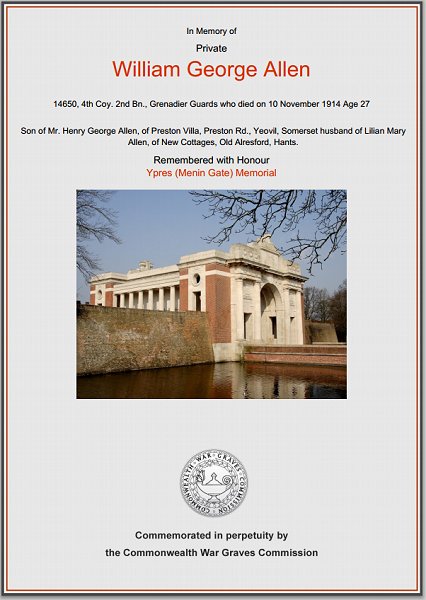yeovil at War
William George Allen
Killed at the Battle of Langemarck, aged just 19
William George Allen was born in 1887, the son of Henry George Allen of Preston Plucknett. Sadly, very little is known of William's early life although it is known from his Service Number 14650 that he enlisted in the 4th Company, 2nd Battalion, Grenadier Guards on 17 February 1910, at the age of 23 - which probably explains why there are so few civilian records about him.
It would appear that William married Lilian Mary Ruffle in the autumn of 1914 at Farnham, Hampshire. This was, presumably, immediately before the outbreak of war at which time the 2nd Battalion of the Grenadier Guards were stationed in Chelsea Barracks as part of the 4th (Guards) Brigade of 2nd Division.
 When
war broke out
the Battalion
sailed for
France almost
straight away as
part of the
British
Expeditionary
Force (BEF),
landing at Le
Havre on 15
August 1914.
Indeed the 2nd
Division was one
of the first
British
formations to
move to France,
where it
remained on the
Western Front
throughout the
war.
When
war broke out
the Battalion
sailed for
France almost
straight away as
part of the
British
Expeditionary
Force (BEF),
landing at Le
Havre on 15
August 1914.
Indeed the 2nd
Division was one
of the first
British
formations to
move to France,
where it
remained on the
Western Front
throughout the
war.
The 2nd Battalion were straight into battle and took part in the Battle of Mons.
The Battle of Mons, 23 August 1914, was part of the wider Battle of the Frontiers. It was the first battle fought by the BEF since its arrival in France. On 22 August the five divisions of the BEF (four infantry and one cavalry) reached the Mons-Condé canal and took up positions along twenty miles of the canal. Sir John French, the commander of the BEF, had been expecting to join a French offensive into Belgium, but this plan had been based on a misunderstanding of the German plan. On 22 August the French had suffered a serious setback at the Sambre, when their Fifth Army had been attacked by the German Second and Third Armies.
During the night of 22 August French received a request to launch a counterattack against what was believed to be the right flank of the German army advancing through Belgium. This belief was mistaken. The German First Army was advancing directly towards the British position - there was no open flank to attack. On 23 August the First Army collided with the thin British line. 70,000 British soldiers with 300 guns faced as many as 160,000 Germans, supported by 600 guns. Although they were badly outnumbered, the British did have two big advantages. Both came from the professional volunteer nature of the British army. The British regular soldier of 1914 was expected to be able to fire fifteen aimed shots per minute. At Mons the British rifle fire was so rapid and so accurate that many Germans believed they had been facing massed machine guns.
Although the British fought well and inflicted disproportionate casualties on the numerically superior Germans, they were eventually forced to retreat due both to the greater strength of the Germans and the sudden retreat of the French Fifth Army, which exposed the British right flank. Though initially planned as a simple tactical withdrawal and executed in good order, the British retreat from Mons lasted for two weeks and took the BEF to the outskirts of Paris before it counter-attacked in concert with the French, at the Battle of the Marne.
The First Battle of the Marne, fought from 5 to 12 September 1914, resulted in an Allied victory against the German Army. The battle was the culmination of the German advance into France and pursuit of the Allied armies which followed the Battle of the Frontiers in August, which had reached the outskirts of Paris. The counterattack of six French field armies and the British Expeditionary Force (BEF) along the Marne River forced the German Imperial Army to abandon its push on Paris and retreat north-east, leading to the 'Race to the Sea' and setting the stage for four years of trench warfare on the Western Front. The Battle of the Marne was an immense strategic victory for the Allies, wrecking Germany's bid for a swift victory over France and forcing it into a drawn-out two-front war.
The First Battle of the Aisne was the Allied follow-up offensive against the right wing of the German First and Second Armies as they retreated after the First Battle of the Marne earlier in September 1914. The offensive began on the evening of 13 September, after a hasty pursuit of the Germans. When the Germans turned to face the pursuing Allies on 13 September, they held one of the most formidable positions on the Western Front. Low crops in the unfenced countryside offered no natural concealment to the Allies but deep, narrow paths cut into the escarpment at right angles, exposing any infiltrators to extreme hazard. In dense fog on the night of 13 September, most of the BEF crossed the Aisne on pontoons or partially demolished bridges. Under the thick cover of the foggy night, the BEF advanced up the narrow paths to the plateau. When the mist evaporated under a bright morning sun, they were mercilessly raked by fire from the flank. Those caught in the valley without the fog's protective shroud fared no better. It soon became clear that neither side could budge the other and since neither chose to retreat, the impasse hardened into stalemate that would lock the antagonists into a relatively narrow strip for the next four years.
On 19 October 1914 the 2nd Division began a protracted period of fierce combat in what was to become known as the First Battle of Ypres, as the Germans opened their Flanders offensive and the Allies steadfastly resisted, while seeking their own chances to go on the attack wherever possible. Fighting continued, with heavy losses on both sides, until 22 November, when the arrival of winter weather forced the battle to a halt. Sadly William Allen was killed on 10 November 1914. He was aged 27.
William Allen is commemorated on Panels 9 and 11 of the Ypres (Menin Gate) Memorial, West-Vlaanderen, Belgium and his name is inscribed on the Preston Plucknett War Memorial.
gallery

The Commonwealth War Graves Commission certificate in memory of William Allen.